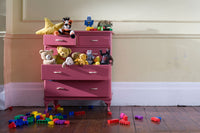By Michelle Mady
Keeping kids organized is a tall order, especially when they are the key reason for such organizational needs—so use them to your advantage! It is true that kids, especially toddlers, love to dump out buckets of toys and clean out the kitchen cabinets. But what if I told you that they equally love to fill those buckets and cabinets?
With a little knowledge of child development and a bit of savvy set up, even the messiest child can lend a helping hand when it comes to keeping your home organized.
With a little knowledge of child development and a bit of savvy set up, even the messiest child can lend a helping hand when it comes to keeping your home organized.
CHILD DEVELOPMENT—DUMP AND FILL
Children experiment with the world around them to understand how things work. The best way for them to do this is to participate in activities with immediate consequences. This “cause and effect” play can be used to your advantage. Have a few bins for toys that are easily lifted and dumped by your child. Allow them to practice refilling the bins once dumped. Make sure to cheer them on as they scoop up those toys.
CHILD DEVELOPMENT—MAKE IT A GAME
I always tell my students’ parents that a timer is my best classroom management tool. Can your preschooler pick up all of the blocks before the timer goes off? How many stuffed animals can they throw back into their bed before they hear the alarm? A simple game or competition can make organizing their toys so much easier. Make sure to pick out one type of toy or one area to make sure things are organized in the right place.
If you have a more visual learner, check out classroom timer videos on Youtube. They have them for various amounts of time, and some of them end with a silly action. There is a shark timer that my students love, for instance; the shark chomps away when the timer goes off, and I let them chomp their arms in celebration!
SAVVY SET UP—PICTURES
Labeling bins and shelves is a great way to create realistic expectations for your children when asking them to get organized. Even an older child can get overwhelmed with vague directions like “organize your toys.” With some specific guidance and pictures (and words) labeling the bins and shelves, they are much more likely to be able to keep their things organized. Not only does this help them, but you can easily see what is missing from a shelf or what has been actually picked up and put back where it belongs.
SAVVY SET UP—VISUAL SCHEDULES
Organization of “stuff” is really helpful, but if their days are organized, children are more likely to keep their belongings organized. Make sure to have a good routine set in place for your children and put changes or special events on your calendar in picture form. If you are going to expect rooms to be cleaned on Sundays, put a picture of that on your calendar for every Sunday. Paper calendars might be a thing of the past for adults, but consider having one for the children in your house. Color school or camp days a certain color and make notes that they can understand on days where your routine differs. Having a predictable schedule (as much as possible) can help keep everyone on the same page.
Organization for children doesn’t necessarily come naturally. Let’s face it—many adults could use some help with this skill. But by creating realistic expectations with guided support any family can get organized. Don’t forget how much an element of fun can make things happen, too!
-
About the author: Michelle is a mom of 5 children ranging in age from 5 to 15. As a toddler and preschool teacher, she shares experiences, activities and guidance to other parents, as both a parent and as a professional early childhood educator, at any stage of their parenting journey.




